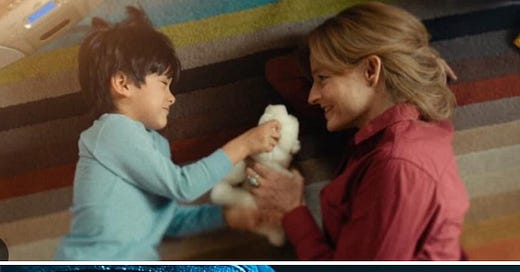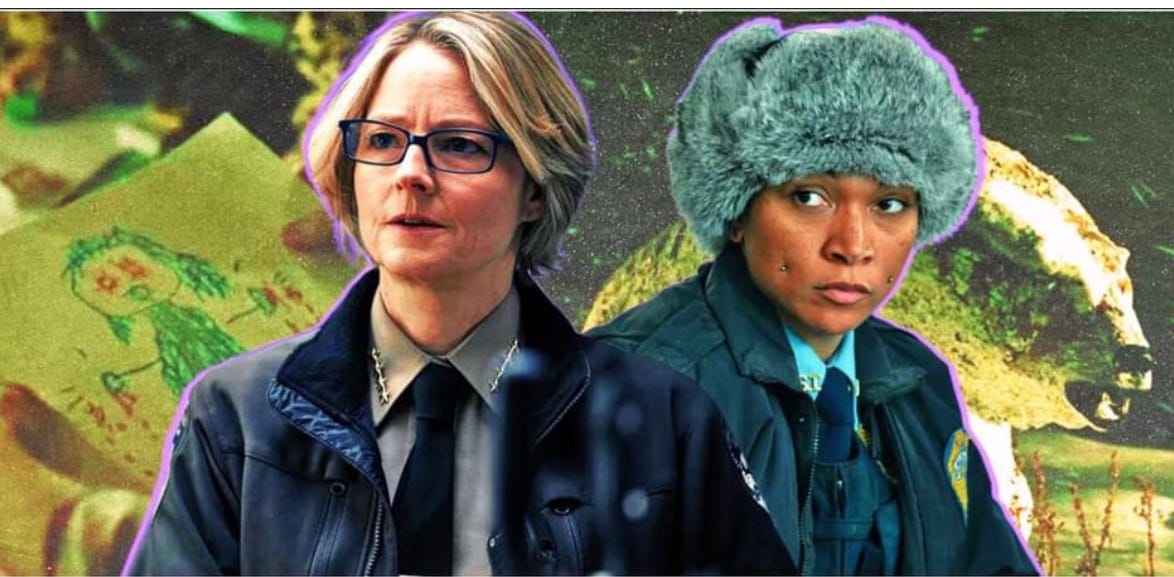Opening the Hatch: On the Finale of "Night Country"
You can’t just throw the stuffed toy out the window and think you’ve banished grief. As a story about the weight of loss, the relief of letting go, and the recovery of self NC is extraordinary
WARNING: SPOILERS FOR FINALE!
The first few scenes, in which Liz Danvers and Angeline Navarro, in search of answers to the killing of Annie, travel down the entrails of an ice-tunnel that seems determined to swallow them, could have been from an Indiana Jones movie. Having the indigenous female employees of the lab mount a collective assault on the knowledge-and-power hungry scientists who killed Annie is a feminist wish-fulfillment, but basically a gimmick out of Agatha Christie’s “Murder on the Orient Express.”
But while in the typical detective drama, unraveling the clues and resolving the mysteries are the main point, in “Night Country” that’s just the scaffolding that keep viewers engaged while deeper dramatic work is being done. And we were engaged. Week after week, in Facebook groups and media reviews, people posed questions and offered theories. Was the one-eyed polar bear real, a hallucination, or a spirit? What was the meaning of the spiral symbol the series shared with “True Detective Season one”? How come Rose cooked so much food on Christmas Eve? And who is “She”?
The speculations continued after last night’s finale, both because Issa Lopez, who has said she loves “incomplete” stories, left several questions unanswered, and because she’s also said that everything that happens in the series can be read in two different ways. Everything can be explained rationally. And everything can be explained in terms of the “more than this. So much more” that Navarro keeps poking at Liz about: “I know you feel it too,” “She’s calling,” “He’s out there, Liz.” etc.
But what if we stop theorizing and pay attention to what Issa Lopez has said about the show? Then a different window opens up, and we see the show, not about (a rather forced) solution to some murders, but an exploration of the characters’ personal struggles through the darkness of loss and grief, and emergence into the light—not of “moving on” (as Rose says to Pete after they’ve dumped Hank’s body in the ocean, “the worse part is what comes after. Forever. That the worst fucking part”) but of “opening the hatch” to their feelings—including their need for each other, frozen over by years of alienation.(“Do you think I want to work with you?” Navarro asks in the first episode; “Yeah, I do,” Danvers answers. It’s a tiny early clue to the possibility that mutual mistrust isn’t the whole story.)
What has Lopez herself said about the show? One of her comments is unsurprising: that the main theme of “Night Country” is about going through darkness and coming into light. The town of Ennis literally endures that every year, and Lopez uses the unrelenting darkness both for atmosphere and as a metaphor for the “dark night of the soul” that the main characters go through. The notion of a journey through dark into light also signals to us that we should expect some sort of optimism…or release…or enlightenment…or restoration (chose any or all) by the end of the series.
And that happens. Navarro learns her Inupiaq name (Siquinnaatchiaq, which means “the return of the sun after darkness”) and her divided self (“How can I arrest these people who are my people?”) finds the answer: “I am them. They are me. I can’t be a cop here anymore.” And Danvers, with the help of Navarro, stops hold(en)1 down the hatch against her grief over Holden. It’s been “calling” her since the dark descended, through intrusive memories of playing peek-a-boo with Holden—memories she tries to banish by throwing his toy bear out the window only to have it return in the form of a real one-eyed bear (the toy itself is also retrieved by Navarro, who leaves it on Danver’s bed.)
Navarro sees the one-eyed bear, too; she’s the conduit for several of the dead in the series, including Annie and Holden. She “carries” Annie—a huge burden that she believes will only be lifted by solving the mysteries of her death. And Holden speaks to her too. So long as Danvers won’t let him in, Navarro is his spokesperson.
“He’s out there, Liz…and he says that…..”
But Danvers won’t hear of it, and explodes in a rage. Her resistance is her defense against the untruth of her own words earlier in the series: “The dead are dead. There’s nothing except us. We’re here, Navarro—alone. The dead are fucking gone.” While Navarro sees that there is “comfort” in allowing in the “so much more,” Danvers is committed to keeping that hatch tightly closed. But after her rage at Evangeline she can’t get warm, even under several layers of blankets. She’s haunted. She’s been haunted throughout the series.
Then, looking for Navarro, Liz falls through the ice and feels Holden reach out to her. And when she’s pulled out and away from her own death by Navarro, who cradles her trembling body and helps her to breathe (“blow out, just like a birthday candle”) whole, vibrant memories are released of Holden’s birthday, of the time when the three were a family, and the tough Danvers face (thank you, Jodie Foster, for letting your face be as it ages) becomes so tender. Now she wants Navarro to finish the sentence.
“What did he say?”
.“He says that he sees you. He sees you, Liz.” And Navarro puts a hand over one of Danvers’ eyes, just like in the peek-a-boo game she played with Holden: “I see you!! Do you see me??”
The scene is all you really need to know about the one-eyed bear. Put it together however you like, or just accept it—as I do—for the emotionally brilliant moment that it is. And the actresses are wonderful in it. Jodie groans and melts into sorrow, Navarro rocks her like a baby, and we hear “Twist and Shout” again—but this time not as a rocking dance number, but as a slow, ballad, a love song: “Let me know you’re mine.”
That brings me to a more surprising comment of Issa Lopez’s:
“When I talked to HBO about the first draft, I was like, deep down, this is a rom-com.These are two characters that love each other, found each other and fell in love, and then fell out of love terribly. Now they’re enemies. And that’s when we meet them. And the show is the story of how they fall back in love. This is friendship. But in the end, it’s the same thing.”
As I wrote in a earlier stack about the show, the comment made me hopeful that “Night Country,” like the first season of “True Detective,” would give us the pleasure of re-uniting that is classic comedy. Surely that’s what Lopez has in mind (not a Tom Hanks/Meg Ryan vehicle) when she refers to a show like “Night Country” as a “rom-com.” The series doesn’t have a whole lot of laughs (it does have some; in this episode, when Danvers says “Want some coffee?”after they’ve tortured Raymond in the most perfect but horrible way possible, it was pretty funny.) But jokes are not the essence of classic comedy (as in Greek and Shakespeare.) In classic comedy, things fall apart and then, in the end, come together.
Those who enjoy searching for links between the first season of “True Detective” and “Night Detective” won’t just find them in symbols. For me, it was the evolving relationship between Rust and Marty that made the series more than just an extremely well-made thriller. And despite Nic Pizzolatto’s attempts to detach season 1 and 4 from each other, it’s the two women detectives—not the many clever “easter eggs”—that, like Rust and Marty, make the series compelling.
In my earlier stack, I wrote:
Like Rust and Marty, Danvers and Navarro are an oil-and-water team. They have different philosophies of life—both Marty and Liz don’t go for anything they can’t see or touch, while Rust and Navarro are tempted by the metaphysical. There’s also betrayal and deep alienation between them. But while Rust and Marty break with each other because of events that take place during the season, the hostility between Danvers and Navarro is the result of a past event (which is only just beginning to be clarified in this episode.) I’m pretty sure that, like Rust and Marty, going through the dark tunnel of the season—much darker in “Night Country,” both literally and figuratively—is going to change things.
I was right about that. And it’s why I choose to believe that Evangeline—the living Evangeline—is who comes out onto the deck at the cabin overlooking the now unfrozen ocean. I can make an argument for it: Liz has just told the investigators that “you won’t find Navarro out there on the ice” and we see her and Leah, in the car, laughing and eating snack food en route to what appears to be a cabin on the ocean.
But of course you can see it otherwise. Issa Lopez has said that the series was “carefully crafted as an ink blot test for you to discover yourself as an audience member.” But she also reminds viewers that some indigenous people, like the aboriginals of Australia “go and walk about, find themselves and then come back, which I think is what Kali embraced [for the character.]”
Kali Reis herself says it’s left “open”:
I think her sister was the one thread holding Navarro together. Navarro wouldn’t go all the way off the deep end because she had somebody to worry about. So once she’s gone, there’s nothing else holding her. She can go off the deep end. She can beat the shit out of these guys and not even care. She can just dive into things. So I like to think that regardless of her decision to walk into the ice like her sister does, I don’t think she does that. I think she just goes off into a place where she can be herself without any responsibilities. And if she did either walk into the ice like her sister or stay around, the only person she would ever come back to see, whether it’s in the spirit world or physical world, would be Danvers.
Evangeline and Liz, together. That’s the story I love, and the one I see in the “ink blot.” I imagine Leah at the house, too, perhaps in the kitchen cooking up an Inupiaq delicacy. Will Peter and Kayla and Darwin ever be invited too? Perhaps. But for now, the two on the deck looking out over the unfrozen sea is enough.
****
If you’d like to read my two previous stacks on “Night Country,” you can find them here:
Ghosts
The dead are dead,” Liz Danvers (Jodi Foster) insists. “There’s nothing except us. We’re here, Navarro—alone. The dead are fucking gone.” Except at that moment, Danvers is proving herself wrong, as she throws Holden’s toy polar-bear out the door, trying to convince Navarro—and herself—that she means what she says. But it isn’t that easy to banish the de…
Brown Girl Magic
“I believe that every storyteller has a very specific, peculiar, and unique relation to the stories they create…I wrote this with profound love for [“True Detective” Season One] and love for the people that loved it. And it is a reinvention, and it is different, and it’s done with the idea of sitting down around the fire, and [let’s] have some fun and h…
Sorry, couldn’t help myself. Just be glad I didn’t put it in the title.







Brilliant deconstruction of the episode.
Susan Bordo, thank you for your creative and intelligent writing